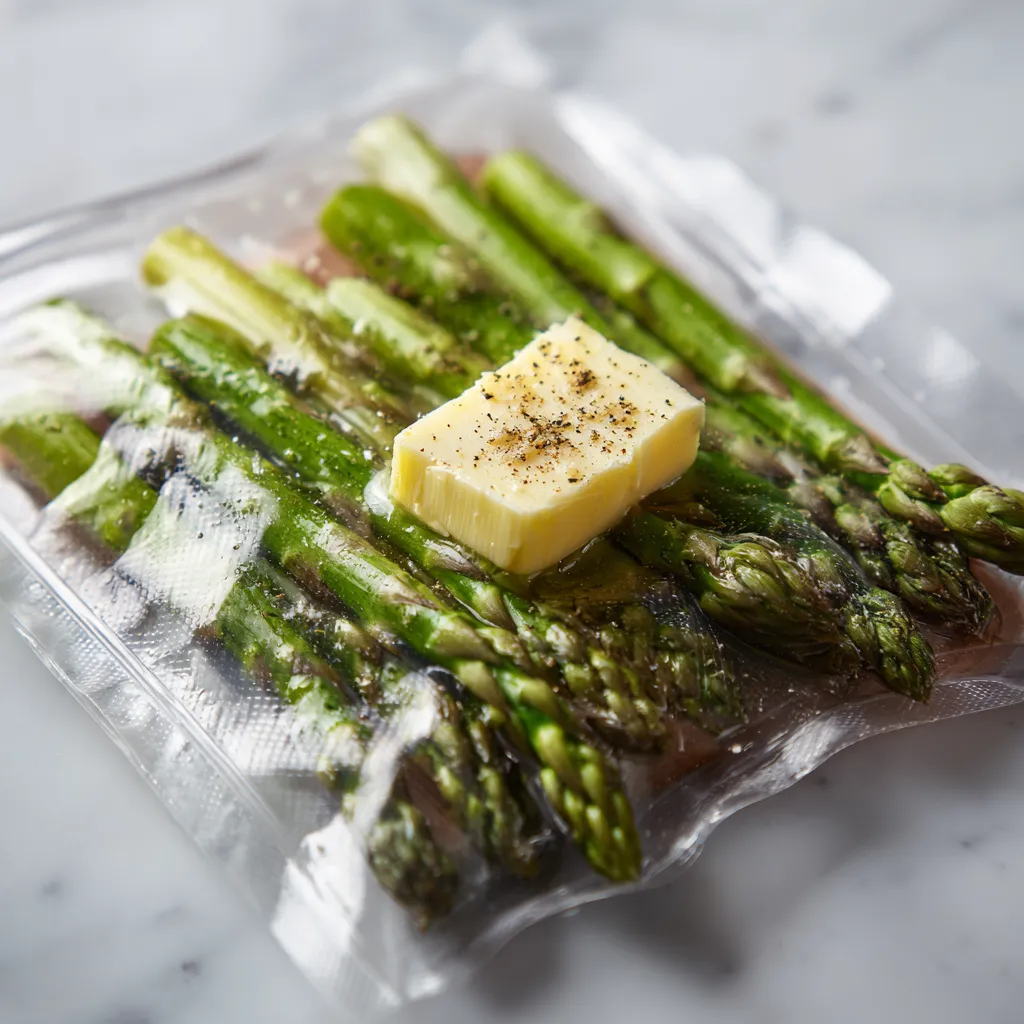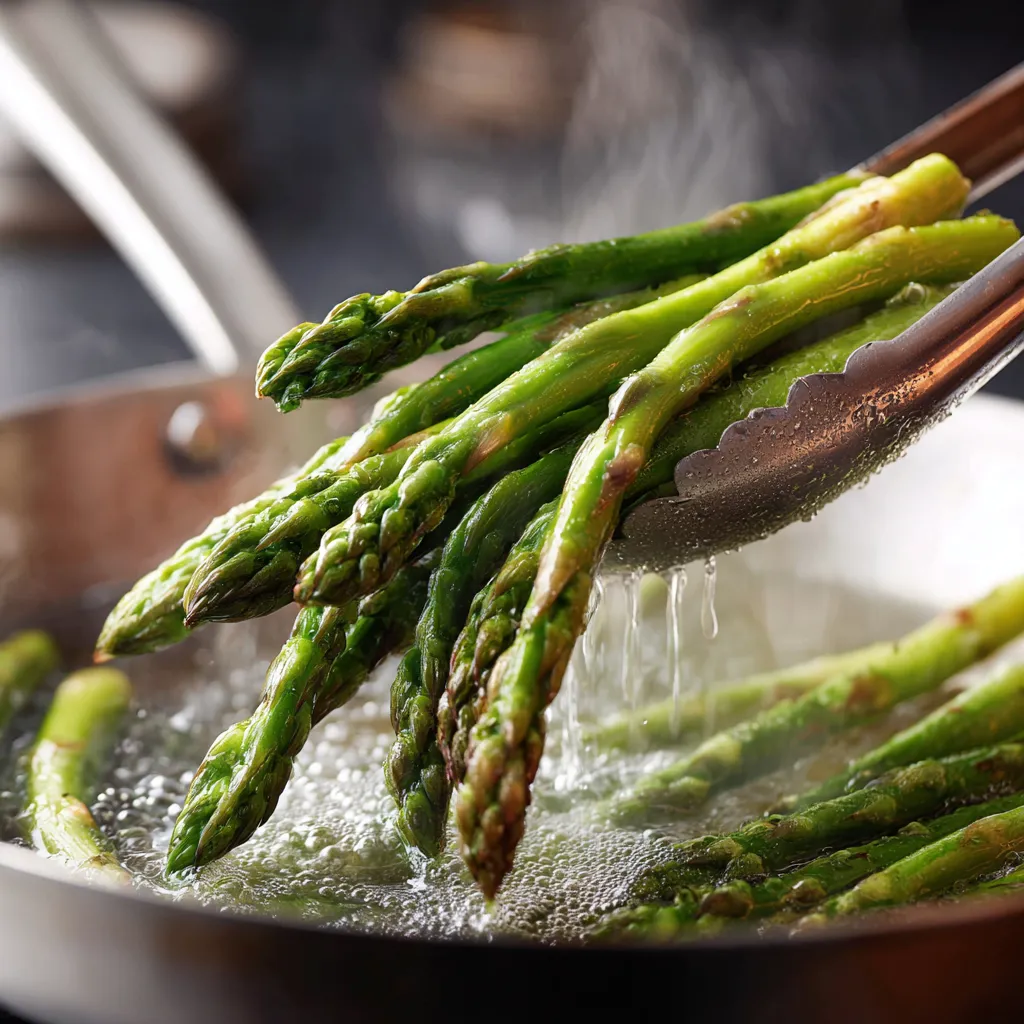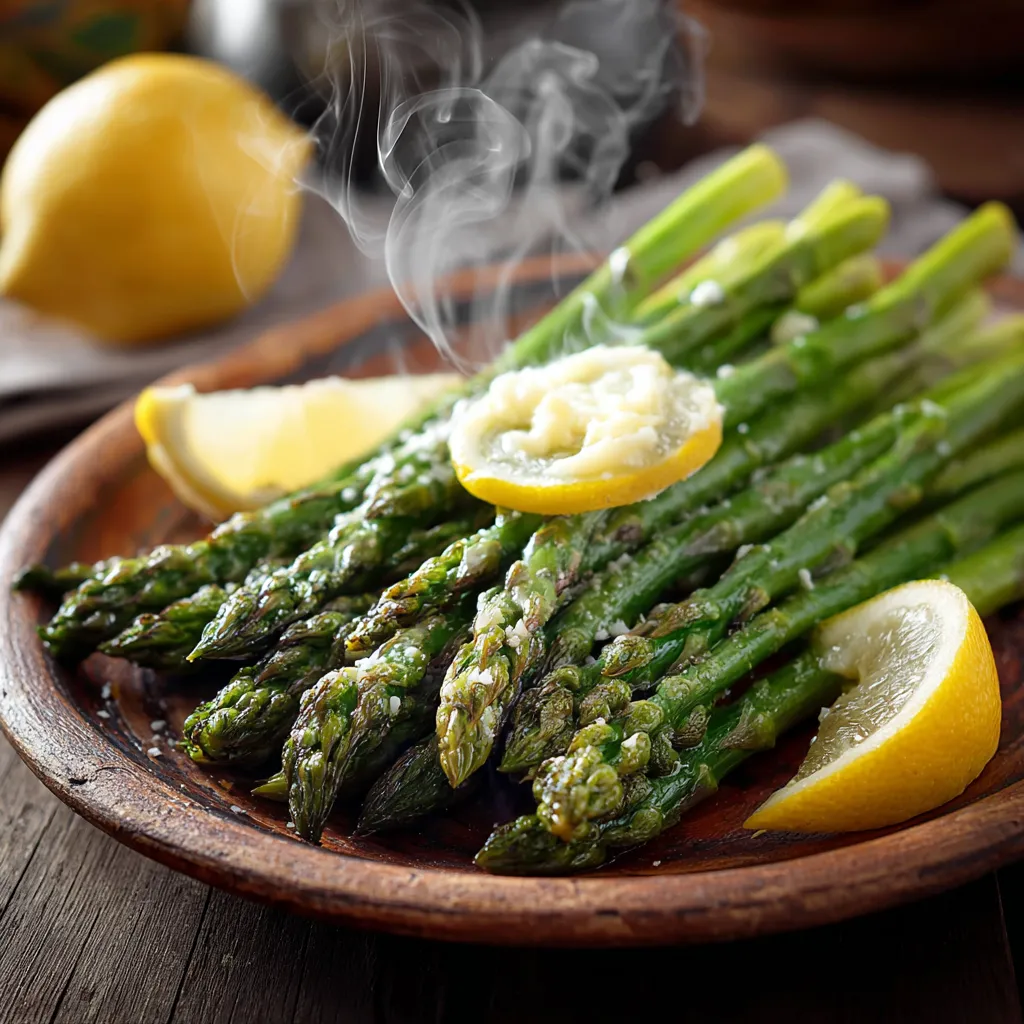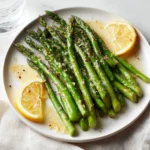➤ Table of Contents
I’ll never forget the first time I tried sous vide vegetables. I was experimenting with asparagus, craving something buttery and bright but still crisp—not floppy. I seasoned it simply, sealed it, and dropped it in the bath at 180°F. Just 12 minutes later, I had stalks that were vibrant green, evenly cooked, and melt-in-your-mouth tender. That moment hooked me. This vegetable sous vide recipe has been on repeat ever since.
Growing up in sunny Florida, we had fresh produce year-round. From vibrant green beans to sweet carrots pulled straight from the dirt, vegetables were always on the table. But even the freshest ingredients can turn dull with the wrong cooking method. Too much heat, not enough seasoning, or rushing through prep—it’s all too easy to end up with limp broccoli or bitter Brussels sprouts. That’s why discovering sous vide felt like flipping a switch.
The first time I used a vegetable sous vide recipe, it was a total game-changer. I didn’t need expensive gear or culinary school skills—just a water bath, a reliable temperature, and some patience. Suddenly, veggies weren’t just an afterthought; they were the highlight. Whether it’s earthy beets, snappy asparagus, or buttery carrots, a vegetable sous vide recipe helps coax out the flavor locked inside each bite. And even better, it preserves the nutrients and vibrant color that traditional boiling or roasting often destroys.
If you’ve ever bit into mushy carrots or overcooked asparagus, you know the struggle. Vegetables can be unforgiving. But that’s exactly where a good vegetable sous vide recipe shines. The low-and-slow technique gives you consistent, repeatable results. No burnt edges. No soggy middles. Just perfectly cooked vegetables, every time.
I use a vegetable sous vide recipe almost every week in my kitchen. It’s my go-to method when I want hands-off cooking that still delivers on flavor. Want to batch cook carrots for the week? Drop them in the bath for an hour and forget about them. Hosting a dinner party? Impress guests with tender-crisp Brussels sprouts that hold their shape and pop with flavor. You can even prep the entire meal ahead of time using different vegetable sous vide recipes in the same bath—just stagger the start times based on their density.
One of my favorite things about sous vide is how it brings out the natural sweetness in root vegetables. When you follow a vegetable sous vide recipe for beets or sweet potatoes, you’re not just cooking—you’re creating a flavor profile that’s deeper and more complex than any oven or skillet can achieve. The cell walls break down gently, releasing sugars without burning or drying. It’s magic, really.
This article walks you through my absolute favorite vegetable sous vide recipe—lemon butter asparagus—but it also goes further. We’ll cover which veggies work best, which ones don’t, and how to tweak your approach based on timing and temperature. Think of this as your personal roadmap to mastering vegetables in a sous vide bath.
If you’re skeptical, start with asparagus. Just 12 minutes at 180°F, and you’ll see why this vegetable sous vide recipe is a staple in my rotation. From there, move on to carrots, Brussels sprouts, and even butternut squash. Each vegetable has its ideal time and temp, and once you get familiar, you’ll be crafting your own vegetable sous vide recipes in no time.
So if you’re ready to level up your veggie game, a great vegetable sous vide recipe is where to start. This isn’t just another way to cook—it’s the most reliable, hands-off, flavor-boosting technique for vegetables that I’ve ever used. Let’s dive into the juicy details and get those vegetables tasting as good as they were meant to.
PrintVegetable Sous Vide Recipe
Perfectly tender asparagus with butter, garlic, and lemon. This vegetable sous vide recipe delivers vibrant flavor and foolproof texture in just 12 minutes.
- Prep Time: 5 minutes
- Cook Time: 12 minutes
- Total Time: 17 minutes
- Yield: 2 servings 1x
- Category: Side Dish
- Method: Sous Vide
- Cuisine: American
- Diet: Vegetarian
Ingredients
1 bunch asparagus
2 tbsp butter, cut into 4 pieces
1 tbsp fresh lemon juice, about 1/2 lemon
1/2 tsp kosher salt
1/2 tsp garlic powder
1/4 tsp freshly cracked black pepper
Instructions
1. Preheat water bath using immersion circulator to 180 degrees F.
2. Add asparagus, salt, pepper, and garlic powder to a vacuum seal bag. Shake it to disperse seasoning. Add butter to the bag and spread evenly. Vacuum seal, doing your best to keep the asparagus in a single layer.
3. Add the vacuum sealed asparagus to a water bath preheated to 180 degrees F and cook for 12 minutes.
4. Once done, open the bag and shake around to evenly coat stalks in seasoning and butter.
5. Squeeze lemon over the asparagus and toss again. Serve.
Notes
For crisp-tender asparagus, do not exceed 15 minutes. For softer texture, cook up to 18 minutes. Use vacuum seal or zipper bag with water displacement method.
Nutrition
- Serving Size: 1 cup
- Calories: 90
- Sugar: 2g
- Sodium: 310mg
- Fat: 7g
- Saturated Fat: 4g
- Unsaturated Fat: 3g
- Trans Fat: 0g
- Carbohydrates: 4g
- Fiber: 2g
- Protein: 2g
- Cholesterol: 15mg
Why Sous Vide Vegetables Just Work
The beauty of this technique is consistency. No more standing over boiling water or stressing about uneven doneness. With sous vide, you set the temperature, seal the bag, and walk away. This vegetable sous vide recipe features asparagus, but the method works just as well for a variety of vegetables—from broccoli to carrots to Brussels sprouts. In fact, a good vegetable sous vide recipe can easily be adapted based on your seasonal favorites or what you have in the fridge. For example, we use precise temperatures in our sous vide broccoli recipe and create deep caramel notes in this sous vide carrots guide.
Once you get the feel for it, vegetables become one of the easiest things to cook using a vegetable sous vide recipe. It’s ideal for everything from weekly meal prep to holiday dinners—and it even wins over picky eaters thanks to its perfect texture and flavor.

How Long to Sous Vide Vegetables for Best Results
When it comes to sous vide cooking, vegetables behave a little differently than proteins. They typically need higher temperatures and more precise timing to reach the sweet spot of tender yet structured. For asparagus like in our featured vegetable sous vide recipe, 180°F for 12 minutes is perfect for a slightly crisp bite. But root veggies? Those take longer.
Here’s a quick cheat sheet:
| Vegetable | Temp (°F) | Time |
|---|---|---|
| Asparagus | 180°F | 12 min |
| Carrots | 183°F | 60–90 min |
| Beets | 185°F | 3–4 hrs |
| Brussels Sprouts | 185°F | 1 hr |
Root vegetables like beets and carrots are denser and need longer cook times to break down their fibers properly. Learn more in our sous vide root vegetables guide, where we dive into timing for everything from sweet potatoes to turnips.
Why Texture Matters in a Vegetable Sous Vide Recipe
A key benefit of any great vegetable sous vide recipe is the ability to nail texture every single time. No more guessing, no fork-poking, and definitely no mushy middles. With traditional methods, asparagus cooked just a little too long can go from crisp to soggy fast. But with sous vide, you control the temperature to the exact degree—and that precision makes all the difference. For instance, when using a vegetable sous vide recipe at 180°F, asparagus stays perfectly crisp-tender, never stringy or limp.
This method also shines when you want to batch cook different vegetables. With a little planning, you can cook broccolini and carrots in the same water bath by simply staggering their start times. That kind of flexibility makes sous vide ideal for real-life cooking, whether you’re making weeknight dinners or prepping holiday sides. Try pairing asparagus from this vegetable sous vide recipe with a sous vide salmon fillet, or serve your carrots alongside a perfectly cooked steak for a complete meal.
Another win? Sous vide keeps your vegetables bright and vibrant. Say goodbye to dull, grey veggies and hello to bold green asparagus, deep orange carrots, and ruby-red beets. This method locks in color, nutrients, and flavor—so every bite tastes as fresh as it looks.

Is a Vegetable Sous Vide Recipe Worth the Effort?
Why Sous Vide Vegetables Are Worth It
If you’re wondering whether it’s really worth using sous vide just for vegetables, the answer is a clear yes—especially when it comes to texture, flavor, and consistency. Unlike boiling or roasting, a well-executed vegetable sous vide recipe lets you hit that sweet spot of doneness without overcooking or drying things out. It’s the secret behind restaurant-quality asparagus that still has bite, every time.
Using a vegetable sous vide recipe also helps preserve essential nutrients that are often lost in traditional cooking methods like boiling or steaming. And you can forget about hovering over a stovetop. Just season, seal, drop into the water bath, and go about your day. Whether you’re prepping Sunday meals or making sides for a busy weeknight, vegetables like sous vide green beans or glazed carrots come out perfectly and store beautifully in the fridge.
What makes a vegetable sous vide recipe truly shine is its versatility. Want a bolder taste? Add garlic, lemon zest, rosemary, or even a sprinkle of Parmesan right into the bag. Prefer your carrots tender or with a bit of crunch? Simply adjust the time. That level of control is what sets this cooking method apart—and why so many home cooks are making the switch.
Common Drawbacks (and How to Avoid Them)
Every cooking method has its quirks, and that includes sous vide. When using a vegetable sous vide recipe, the biggest considerations are time and equipment. It does take longer to cook root vegetables this way compared to steaming or roasting, especially for dense options like beets or sweet potatoes. And yes, you’ll need a sous vide circulator and vacuum-sealable or zipper bags—but once you’re set up, the process is surprisingly simple and hands-off.
One question that comes up often with any vegetable sous vide recipe is safety. Can bacteria grow in sous vide cooking? Technically, yes—but only if food sits too long in the danger zone (between 40°F and 130°F). That’s why every vegetable sous vide recipe on our site, including this one, uses cooking temperatures well above 180°F to ensure food safety. If you’re new to this method, check out our beginner’s guide to sous vide for peace of mind and smart tips.
Lastly, not every vegetable is ideal for sous vide. Leafy greens like spinach or very delicate vegetables like thin zucchini slices tend to get mushy and lose their appeal. A reliable vegetable sous vide recipe works best with heartier veggies—think asparagus, carrots, potatoes, or Brussels sprouts. These options retain their shape, absorb flavors beautifully, and are easy to season and seal for consistent results.
What Not to Sous Vide and How to Keep It Safe
Vegetables That Don’t Belong in a Sous Vide Bag
While this vegetable sous vide recipe delivers tender-crisp asparagus every time, not every veggie plays nice in a water bath. Leafy greens like spinach, kale, or arugula are poor candidates—they wilt too quickly and can turn slimy. Delicate items like sliced zucchini or cucumbers lose structure and become mushy.
Instead, stick with sturdy produce: root vegetables, stalky greens (like broccolini), or anything you’d normally roast. If you’re curious, check out how we prepare sous vide Brussels sprouts and sous vide beets for deeper flavor and color.
As a general rule, if you’d roast it, you can sous vide it.
Food Safety in Sous Vide Cooking
Let’s address the elephant in the room: is sous vide safe? Yes—when done correctly. Bacteria thrive in temperatures between 40°F and 130°F, so it’s critical that your cooking temp exceeds that. This vegetable sous vide recipe uses 180°F, which is well above the danger zone.
To stay safe:
- Always preheat the water bath before adding food
- Don’t cook vegetables below 183°F unless you’re going very long (2+ hrs)
- Use clean bags and a reliable circulator
Proper storage is also key. After cooking, veggies can stay sealed and refrigerated for up to a week. Want to reheat without ruining texture? Drop the sealed bag in a 130°F bath for 10 minutes before serving.
For more on food safety and handling, browse our complete sous vide safety guide.

Conclusion
Whether you’re new to sous vide or just tired of limp, flavorless veggies, this vegetable sous vide recipe delivers the kind of results that make you wonder why you didn’t try it sooner. With just a few ingredients and 12 minutes in the water bath, you’ll get buttery asparagus with vibrant color, crisp texture, and bright lemon-garlic flavor—every single time.
Sous vide gives you the control to cook vegetables exactly the way you like them without overcooking, under-seasoning, or losing nutrients. From carrots to beets and beyond, it opens up a whole new way to cook with confidence.
If you’re ready to level up your plant-based sides or impress guests with perfectly cooked greens, this recipe is your go-to. Try it once and you’ll be hooked—just like I was back in my Florida kitchen. Ready to see what else you can do with sous vide? Start with our easy sous vide broccoli recipe or sous vide sweet potatoes next.
Join us on Facebook and Pinterest for even more delicious recipe ideas!
FAQs
What are the best vegetables to sous vide?
Root vegetables like carrots, beets, potatoes, and parsnips are great for sous vide. Asparagus, Brussels sprouts, and green beans also work well, delivering precise texture and deeper flavor.
Is it worth it to sous vide vegetables?
Yes. Sous vide locks in nutrients, flavor, and texture without overcooking. It’s especially helpful for vegetables that are easily ruined by high heat or inconsistent oven temps.
What cannot be cooked in sous vide?
Avoid leafy greens (spinach, arugula), very soft vegetables, and thinly sliced zucchini. These tend to become overly soft or slimy due to their delicate cell structure.
How long can you sous vide vegetables?
Most tender vegetables like asparagus take 10–15 minutes. Root vegetables can take 1–4 hours depending on size and density. Always refer to a time/temp chart for guidance.
What are the disadvantages of sous vide cooking?
You’ll need specific equipment (circulator, bags) and more time for denser vegetables. Some soft veggies don’t hold up well and can become mushy.
How long to sous vide root vegetables?
Generally, 1–4 hours at 183–185°F. Carrots take 60–90 minutes, beets 3–4 hours, and sweet potatoes around 2 hours for fork-tender texture.
Can bacteria grow in sous vide?
Only if food is held between 40°F–130°F for too long. Sous vide cooking above 140°F prevents harmful bacteria growth, especially when food safety rules are followed.


